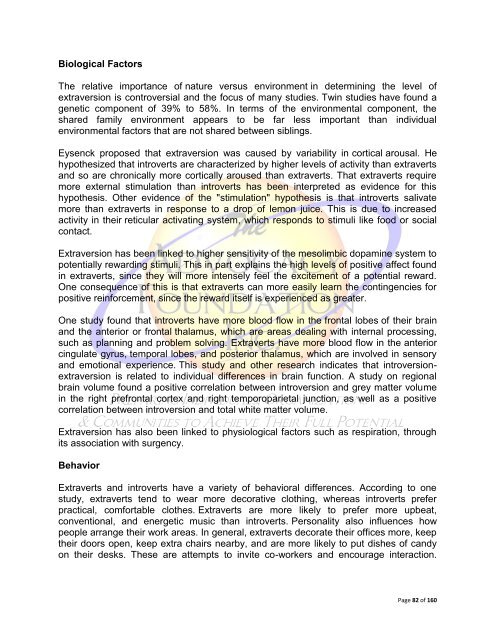The Gift of Introversion
The Gift of Introversion
The Gift of Introversion
You also want an ePaper? Increase the reach of your titles
YUMPU automatically turns print PDFs into web optimized ePapers that Google loves.
Biological Factors<br />
<strong>The</strong> relative importance <strong>of</strong> nature versus environment in determining the level <strong>of</strong><br />
extraversion is controversial and the focus <strong>of</strong> many studies. Twin studies have found a<br />
genetic component <strong>of</strong> 39% to 58%. In terms <strong>of</strong> the environmental component, the<br />
shared family environment appears to be far less important than individual<br />
environmental factors that are not shared between siblings.<br />
Eysenck proposed that extraversion was caused by variability in cortical arousal. He<br />
hypothesized that introverts are characterized by higher levels <strong>of</strong> activity than extraverts<br />
and so are chronically more cortically aroused than extraverts. That extraverts require<br />
more external stimulation than introverts has been interpreted as evidence for this<br />
hypothesis. Other evidence <strong>of</strong> the "stimulation" hypothesis is that introverts salivate<br />
more than extraverts in response to a drop <strong>of</strong> lemon juice. This is due to increased<br />
activity in their reticular activating system, which responds to stimuli like food or social<br />
contact.<br />
Extraversion has been linked to higher sensitivity <strong>of</strong> the mesolimbic dopamine system to<br />
potentially rewarding stimuli. This in part explains the high levels <strong>of</strong> positive affect found<br />
in extraverts, since they will more intensely feel the excitement <strong>of</strong> a potential reward.<br />
One consequence <strong>of</strong> this is that extraverts can more easily learn the contingencies for<br />
positive reinforcement, since the reward itself is experienced as greater.<br />
One study found that introverts have more blood flow in the frontal lobes <strong>of</strong> their brain<br />
and the anterior or frontal thalamus, which are areas dealing with internal processing,<br />
such as planning and problem solving. Extraverts have more blood flow in the anterior<br />
cingulate gyrus, temporal lobes, and posterior thalamus, which are involved in sensory<br />
and emotional experience. This study and other research indicates that introversionextraversion<br />
is related to individual differences in brain function. A study on regional<br />
brain volume found a positive correlation between introversion and grey matter volume<br />
in the right prefrontal cortex and right temporoparietal junction, as well as a positive<br />
correlation between introversion and total white matter volume.<br />
Extraversion has also been linked to physiological factors such as respiration, through<br />
its association with surgency.<br />
Behavior<br />
Extraverts and introverts have a variety <strong>of</strong> behavioral differences. According to one<br />
study, extraverts tend to wear more decorative clothing, whereas introverts prefer<br />
practical, comfortable clothes. Extraverts are more likely to prefer more upbeat,<br />
conventional, and energetic music than introverts. Personality also influences how<br />
people arrange their work areas. In general, extraverts decorate their <strong>of</strong>fices more, keep<br />
their doors open, keep extra chairs nearby, and are more likely to put dishes <strong>of</strong> candy<br />
on their desks. <strong>The</strong>se are attempts to invite co-workers and encourage interaction.<br />
Page 82 <strong>of</strong> 160

















